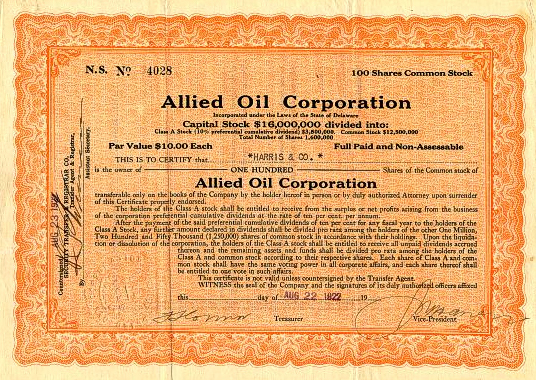by Bruce Wells | Jul 19, 2015 | Petroleum Companies
People seeking obscure financial information probably will not find any petroleum riches here – see Not a Millionaire from Old Oil Stock about a certificate that spawned lengthy litigation with the Coca-Cola Company.
The American Oil & Gas Historical Society, which depends on donations, does not have resources for extensive research. But as AOGHS looks into forum queries as part of its energy education mission, investigations have revealed interesting stories like Mrs. Dysart’s Uraniu Well and Buffalo Bill’s Shoshone Oil Company; others have found questionable dealings during booms and “black gold” fever epidemics like Arctic Explorer turns Oil Promoter.
Visit the Stock Certificate Q & A Forum for updates frequently added to the A-to-Z listing in Is my Old Oil Stock worth Anything? AOGHS will continue to look into forum queries, including these “in progress.”
Pacific Land and Oil
One West Coast newspaper headline told the story. “EASTERN MEN ARE DUPES – Thousands Gained From Investors in a Worthless Oil Scheme in the State of Washington,” proclaimed the Sunday Oregonian on December 10, 1905.
Pacific Land & Oil Company reportedly was floating “vast quantities of oil mining stock upon a susceptible Eastern public” as part of a scheme manipulating federal placer mining laws. The company had been formed by converting fraudulently acquired Jefferson County territory into a “mammoth petroleum oil scheme” and “issuing thousands of shares of stock upon these worthless securities.”
Unsuspecting investors in Milwaukee and Chicago were allegedly fleeced by Stephen A. Douglas Puter, architect of this scam (and many others), who fled Oregon to avoid jail. Puter was captured and returned to serve a two-year sentence in the Multnomah County jail near Portland.
President Theodore Roosevelt pardoned Puter six months early to turn state’s evidence, which he did, implicating several prominent Oregon politicians and federal officials in a number of fraudulent transactions. The conman wrote Looters of the Public Domain – complete with incriminating documents and photographs of his co-conspirators. Puter was a free man by 1908.
Pacific States Oil Company
The Pacific States Oil Company was one of hundreds of petroleum companies that pursued oil unsuccessfully in the state of Washington. The company drilled south of Olympia in Thurston County in 1914. The attempt was widely promoted with ads in the Centralia Daily Chronicle Examiner.
“You can purchase Pacific Oil Company’s stock for 15 cents per share on easy payments. How high it will go, we will not attempt to say,” noted one ad, which added, “You know how oil stock went up in Calgary, from $12 to $200 in one week. There is no reason why ours should not go up proportionately when the well comes in.”
Pacific States Oil partnered with Morgan Oil Company to drill 750 feet deep with their first well, located southwest of Grand Mound, Washington. Despite enthusiastic newspaper advertising campaigns, the company could not raise sufficient drilling funds and folded.
Washington’s first and only commercial oil well didn’t arrive until 1957. The Sunshine Mining Company’s Medina No. 1 well flowed 223 barrels a day from a depth of 4,135 feet near Ocean City. “About 600 gas and oil wells have been drilled in Washington, but large-scale commercial production has never occurred,” reported the Commissioner of Public Lands in 2010.
Pacific States Petroleum Company
Two years after Pacific States Petroleum Company was founded, the Los Angeles Herald reported the company brought in a producing well in Coalinga – where an 1898 gusher flowed at 1,000 barrels a day and launched an early California drilling frenzy (see California Oil & Gas Company).
In Los Angeles, another of the company’s drilling sites was at the corner of today’s Florence Avenue and Pioneer Boulevard, although more details are elusive. California regulators identified one Pacific States Petroleum site in San Pedro as contaminated by industrial pollutants.
California regulators did substantial research in an effort to pursue Pacific States Petroleum – but results have not been found online. It is not unusual to find early companies whose name and origins have been adopted more than once by later ventures for example, another Pacific States Petroleum filed to do business in California in 2002.
Penn Bayless Oil & Gas Company
Penn Bayless Oil & Gas Company incorporated with a Delaware charter on May 26, 1952. Based in historic Titusville, Pennsylvania, home of America’s first commercial oil well, the new exploration company began by offering 10 million shares with a nominal par value of one cent per common share. An additional 2.25 million shares were offered as “proceeds for acquisition and additional work.”
On September 11, 1952, the Franklin (Pennsylvania) News-Herald reported “Penn-Bayless Oil and Gas Co. of Titusville announced yesterday the acquisition of 640 acres of oil leases in Williston Basin, North Dakota.” The newspaper added that a company spokesman said the leases were in Oliver County in the south-central part of the state near Bismarck. It also reported Penn-Bayless Oil & Gas “was formed this summer and has some 1,200 acres.”
North Dakota officials have no record of the company ever drilling a well. After six years of apparent inactivity, on April 1, 1959, Penn-Bayless Oil & Gas was reported to be “no longer in existence having become inoperative and void for non-payment of taxes.” Although the Robert D. Fisher Manual of Valuable and Worthless Securities in 1967 said the company’s charter was to be reinstated, there was no market for the stock and no subsequent operations evident.
Penn Royal Oil Company
The Penn Royal Oil Company drilled in West Virginia’s Doddridge (1921), Ritchie (1922), Wirt (1922) and Wood Counties (1927) with some limited success. Henry Hinds Peevey of Johnstown was president of the company, but few records survive.
Peoples Oil and Production Company
Contemporary advertisements soliciting investment in the Peoples Oil and Production Company are preserved in 1919 copies of the Fitchburg, Massachusetts, “Sentinel” (December 16, 18, and 20). Library access may be available in addition to online pay-as-you-go services. The ads proclaim operations in Texas’ prolific Burkburnett oilfield where new companies and speculators sought their fortune. Very few found it.
Petroleum Consolidation Company
Edwin L. Drake drilled the first American oil well near Titusville, Pennsylvania, in August 1859. His historic discovery prompted a frenzy of investment and speculation in what is still known as the “Oil Region.” In just five years,the region’s production rose from 4,450 barrels of oil to more than 2 million barrels of oil. Hundreds of new companies formed to capitalize on the drilling bonanza.
However, the petroleum marketplace was extremely volatile as increased production drove down prices. As small companies struggled to survive the fierce competition, seven combined in 1865 to form the Petroleum Consolidation Company (McKinley Oil Company, McKinley Oil Company No. 2, Clifton Petroleum Company, Fountain Petroleum Company, Loomis Oil Company, Barry Oil Company and Devon Oil Company).
The Titusville Herald newspaper, which began publishing in June 1865, made note of these small producers, “most of which were good dividend companies, and which at the time of organization were thought to have been made up on small capitals, representing excellent properties, have now consolidated themselves into one company, under the name of Petroleum Consolidation, reducing their capital to $700,000, or nearly two-thirds below their united original capital.”
The newly combined company’s stock sold for 38 cents per share – but fell to 10 cents in only a few months. Petroleum Consolidation lasted two years before losing its charter for failure to pay taxes. The Titusville Herald – still being published today – maintains an archive that could provide more information. Obsolete company stock certificates occasionally sell on Ebay for about $100.
Petroleum Production Company of America
Here’s an oil company that attracted a Chicago socialite and a U.S. chief geographer. It began with a February 25, 1918, announcement that Anna Thurstrup of Chicago and two other Illinois investors had applied to incorporate the Petroleum Production Company of America, capitalized with $500,000, for the purpose of acquiring and developing petroleum properties.
Joining Thurstrup in founding the company was Marion Luce, a Chicago socialite and investor in a number of companies of the era: 1916 – The United Battery Company (capital stock of $3 million); 1917 – Aristo Company of America (manufacturer of wall and interior decorations capitalized at $1 million); 1918 – The Ideal Laboratories Company (manufacturer of “Lura Toilet Preparations” capitalized at $2 million); and in 1921- Utility Battery Company of America, capitalized at $5 million.
Another of the Petroleum Company of America’s founders was Robert Bradford Marshall, who after graduating in 1888 from Columbian University in Washington, D.C. (now George Washington University) joined the United States Geological Survey. He became its chief geographer by 1918. His oil company soon disappeared – a common fate in the speculative and expensive business of finding petroleum.
Phenix Oil & Gas Company
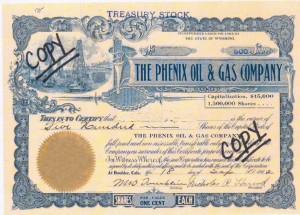 The Phenix Oil & Gas Company incorporated in Cheyenne, Wyoming, on January 29, 1902. The business operated from Cheyenne with nine directors: A. Entwistle; Nicholas Herival (president); George Williams; J.A. Teagarden; C.B. Frantz; J.A. Naylor; E.N. Cook; C.L. Stewart; and J.A. Gillfillan.
The Phenix Oil & Gas Company incorporated in Cheyenne, Wyoming, on January 29, 1902. The business operated from Cheyenne with nine directors: A. Entwistle; Nicholas Herival (president); George Williams; J.A. Teagarden; C.B. Frantz; J.A. Naylor; E.N. Cook; C.L. Stewart; and J.A. Gillfillan.
An earlier Phenix Oil Company was formed in Oklahoma by Edwin Foster – and the historic Indian Territory Illuminating Oil Company – later the Cities Service Oil.
During the turbulent year of Phenix Oil & Gas Company’s incorporation, the New York Times reported Wyoming’s oil drilling excitement – and the entrepreneurs who secured leases anywhere near producing fields to improve their chances of drilling a successful well. Most wells ended up as dry holes. It does not appear that Phenix Oil & Gas Company survived.
Philippine Oil Development Company
As is often the case, stock certificates like the Philippine Oil Development Company, which have no value as securities, may have scripophily value to collectors. Andrés Soriano had long before established ANSCOR (A. Soriano Corporation) as a holding company for investments such as Philippine Oil Development Company. The Philippine Oil Development Company’s 1952 annual report reflected continuing losses. For the colorful story about another Phillipines enterprise of the 1950s, see American-Asiatic Oil Corporation.
Phoenix Oil Company
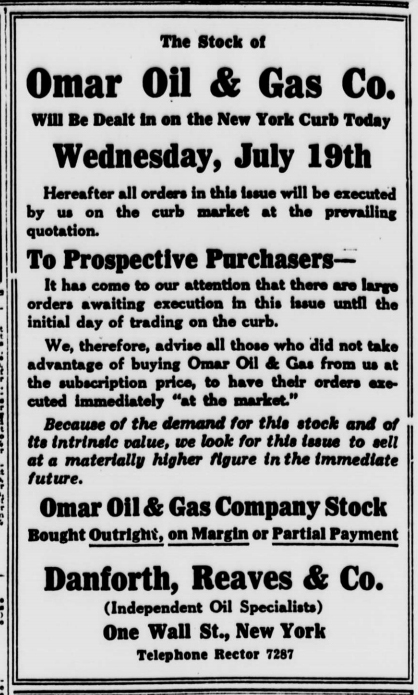 Phoenix Oil Company’s history is in part obscured by the many companies using the same or similar names, but it appears the company began in 1910 as the Omar Oil & Gas Company in West Virginia and then reorganized in Delaware in 1916. Omar Oil & Gas Company’s fortunes diminished over the next decade.
Phoenix Oil Company’s history is in part obscured by the many companies using the same or similar names, but it appears the company began in 1910 as the Omar Oil & Gas Company in West Virginia and then reorganized in Delaware in 1916. Omar Oil & Gas Company’s fortunes diminished over the next decade.
“Announcement is made that stockholders of Omar Oil & Gas Co. can now exchange their shares for shares in the new company the Phoenix Oil Co.,” noted the Pittsburgh Press on March 14, 1928. The newspaper added that Omar stockholders could “exercise the rights under the plan of exchange and subscription.” Such exchanges usually took place at companies in financial trouble; it was likely the result of an oil surplus driving prices and margins down, spelling disaster for under-capitalized ventures. Along with drilling expensive dry holes, price drops and bad luck, another common hazard for exploration companies was litigation.
Phoenix Oil began with the old debts incurred by its predecessor. As court documents later noted, “The slump of 1921 played havoc with the oil industry and prices in that region fell from $3.50 per barrel to $1.50 per barrel and even less.”
Omar Oil & Gas became Phoenix Oil, but was unable to clear a reduced obligation of $200,142.05. The company entered into lengthy but unsuccessful efforts in court to be excused from payment. After a number of appeals, the debt was affirmed by the Supreme Court of Delaware and Phoenix Oil Company disappeared.
Pine Valley Oil Company
About 1920, investors in Burlington, Iowa, financed drilling of four exploratory wells by Pine Valley Oil Company in Webster Parrish, Louisiana, near the town of Cotton Valley. The company had 6,000 acres leased for oil exploration. See First Louisiana Oil Well for more detail on the first and subsequent oil booms that are part of the state’s petroleum history.
Pioneer Oil & Gas Company
Pioneer Oil and Gas Company organized in 1911 in Tulsa with $25,000 capitalization and David M. Hammatt as president. Pioneer Oil & Gas drilled three wells near Muskogee and Oklahoma’s Corporation Commission listed the company in its 1912 annual report, but not thereafter.
Pittsburgh-Youngstown Oil & Gas Company
The Pittsburgh-Youngstown Oil & Gas Company’s July 28, 1920, advertisement in the Lawrence (Kansas) Daily Journal-World proclaimed, “A FEW HUNDRED DOLLARS INVESTED MAY MAKE YOU WORTH THOUSANDS WITHIN THE NEXT FEW DAYS.”
The plan was to drill three wells on a 930 acre lease block, while offering to sell a one-fourth interest in the first well’s production for $50,000. Despite losing drilling equipment in the well that required “fishing” to retrieve, six days later the company found natural gas. The well hit a “4,000,000 cubic foot gasser” five miles northeast of Lawrence (near Six Corners) on the Hemphill farm.
The 1920 well had discovered natural gas at only 735 feet deep – eight feet into the “pay sand” – but the well could not be controlled. Burning natural gas flared from a 15-foot-tall, seven-inch-wide pipe while drillers awaited capping equipment from Independence. “At the present gas rate to consumers, the well is wasting $3,200 a day and will be until it is capped,” noted one observer.
After completing the well, Pittsburgh-Youngstown Oil & Gas filed to incorporate in Delaware on August 5, 1920. With a known natural gas producer, the likelihood of another successful well nearby was improved; the company planned to tie into the Kansas Natural Gas Company pipeline.
Pittsburgh-Youngstown Oil & Gas contracted to drill another well in late September 1921, about 1,200 feet northeast of their natural gas disccovery. But the well was a dry hole at 1,050 feet when “it was pretty definitely determined that the well was off the gas bearing structure. The casing was pulled and the hole was plugged up.”
The company was apparently unable to continue. Kansas state records indicate the Pittsburgh-Youngstown Oil and Gas Company charter was forfeited on December 31, 1924, for failure to file required annual reports.
Plateau Oil & Gas Company
Oil Trade Journal, November 1920, reported a wildcat well drilled by Plateau Oil and Gas Company – the No. 1 Friend well in Section 12 – shut down after drilling 350 feet 20 miles southeast of Ozona in Crockett County.
Plateau Petroleums Limited
In August 1956, Plateau Petroleums Limited was identified with about 150 other companies in a Changing Times Kiplinger Magazine article: “Don’t Be Fooled When You Invest: Here’s a money saver for anyone who likes to speculate in Canadian oil and mining stocks. Don’t buy any of the companies shown here without extra-special investigation. These stocks appear on the ‘Canadian Restricted List’ prepared and released by the SEC which is a list of stocks offered in the U.S. in violation of the Securities Act of 1933. In other words, the sellers have not provided the Securities and Exchange Commission or the public with certain basic information that a prudent investor would insist on having before he bought.”
Pongratz Petroleum Company
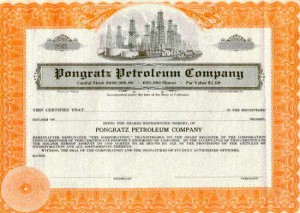 If the stock certificate for the Pongratz Petroleum Company names Gus Pongratz as an officer of the company, it is likely the same individual previously associated with the failed California Independent Oil Organization.
If the stock certificate for the Pongratz Petroleum Company names Gus Pongratz as an officer of the company, it is likely the same individual previously associated with the failed California Independent Oil Organization.
On February 24, 1934, California Independent Oil Organization had leased 560 acres in Crow Indian tribal land in Big Horn County, Montana. Pongratz operated the lease until operations ceased in April 1936.
California Department of Conservation (Division of Oil, Gas, and Geothermal Resources) maps show the Pongratz Petroleum as once having several wells in Los Angeles with Newmark No. 1, Newmark No. 2, Martin No. 1, Dutch No. 1, and the Schelnik No. 1 well marked as “plugged and abandoned.”
Postal Employees Oil & Gas Company
Short-lived 1921 newspaper stock solicitations in New York urged investors to “Get in on the Ground Floor” by purchasing Postal Employees Oil & Gas Company stock, declaring that company owned 135 acres with interests in another 5,200 acres of potentially valuable leases.
One advertisement included annotated maps of Texas to show Postal Employees Oil & Gas Company properties located near famous oilfields like Ranger and Burkburnett as well as the Caddo field in Louisiana. Further inducements to invest noted the Postal Employees Oil & Gas of Texarkana, Texas, was “the only oil company in the world operated and controlled by men in the employment of the U.S. Government. This fact alone is a guarantee of a square deal.”
It does not appear that Postal Employees Oil & Gas was able to raise sufficient funding to drill any wells, but the Texas Railroad Commission may have further research.
Power Petroleum Trust Estate
The Power Petroleum Trust Estate, a creation of Edward H. Power, was sold to the Railroad Employees’ Oil Company of Dallas after an “involuntary petition in bankruptcy” was filed against Power in 1921.
Power Petroleum bonds were exchanged for Railroad Employees’ Oil shares: A face value of $1,000 in Power Petroleum Trust bonds could be exchanged for $666 in Railroad Employees shares. Investment reports noted, “the main difficulty with the Power Petroleum Company was mismanagement. It appears that those connected with the enterprise had very little experience in the oil business.”
There was never any commercial production, but the company’s properties in Texas had value, apparently warranting the Railroad Employees Oil Company gamble that did not pay off.
Powers Manufacturing Company
With the Korean War ongoing in April 1952, the Defense Production Administration approved the newly incorporated (March 31, 1952) Powers Manufacturing Company plan to build a $4.8 million plant in Longview, Texas. The plant was to produce “powdered metal and pipe fitting for use by the petroleum industry.”
Thanks to the East Texas oil boom that began in the 1930s, Longview continued to grow as a hub for oilfield service companies. The industrial park site for the new plant was near the Texas Eastman Company facility and the LeTourneau heavy equipment plant on Highway 149. By 1955, Trailmobile (a subsidiary of Pullman), bought “the huge plant of the Powers Manufacturing Company in Longview…the bid covered all buildings and other real estate formerly owned by Powers Manufacturing Company.”
Prescott-Peoria Oil Company
On March 20, 1920, about 14 miles south of the town of Vernon in Wilbarger County, Texas, the Prescott-Peoria Oil Company’s wildcat oil well blew in with great fanfare. “It gushed for several days and thousands of people flocked to Vernon in a scramble to make investments,” the Wichita Daily Times later noted. “City property soared to almost unheard of values. Lumber yards and stores were opened up overnight. Lease on lands miles from the well brought fabulous prices.”
In anticipation of oil wealth to rival that of nearby Wichita County’s Burkburnett and Electra oilfields, derricks sprang up as quickly as investment capital could be secured. However, Prescott-Peoria Oil’s Sigler No. 1 well proved to be a good but lonely oil producer. As drilling spread, speculators found only one dry hole after another. Prescott-Peoria Oil was one of the casualties.
“The boom collapsed,” reported the Wichita Daily Times. “Oil men folded their maps and slipped away overnight. Investors in acreage and town property found themselves in possession of holdings that were worth but a fraction of their cost.”
Provident Oil & Refining Company
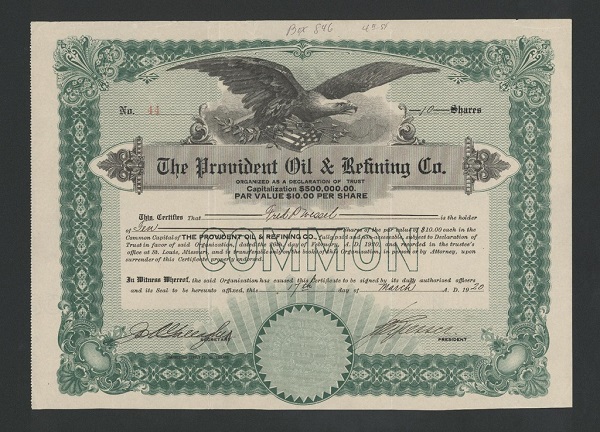 In March 1921, a majority interest in the Provident Oil & Refining Company of Houston was acquired by the Chappell Oil Company of Wyoming. Provident Oil & Refining had been active with a test well in Eastland County, Texas – home of the “Roaring Ranger” well of 1917. The company planned further drilling operations in the Toyah Shallow field and Pecos Valley Territory.
In March 1921, a majority interest in the Provident Oil & Refining Company of Houston was acquired by the Chappell Oil Company of Wyoming. Provident Oil & Refining had been active with a test well in Eastland County, Texas – home of the “Roaring Ranger” well of 1917. The company planned further drilling operations in the Toyah Shallow field and Pecos Valley Territory.
Provident Oil had also searched for oil in central Montana (Cat Creek anticline) and Wyoming’s Salt Creek field. In 1922 the Mutual Oil Company of Denver, Colorado, acquired controlling interest in the Chappell Oil Company and its two wells in Salt Creek producing 6,300 barrels of oil daily.
The stories of exploration and production companies joining petroleum booms (and avoiding busts) can be found updated in Is my Old Oil Stock worth Anything? The American Oil & Gas Historical Society preserves U.S. petroleum history. Please support this AOGHS.ORG energy education website. For membership information, contact bawells@aoghs.org. © 2020 Bruce A. Wells.

 The Phenix Oil & Gas Company incorporated in Cheyenne, Wyoming, on January 29, 1902. The business operated from Cheyenne with nine directors: A. Entwistle; Nicholas Herival (president); George Williams; J.A. Teagarden; C.B. Frantz; J.A. Naylor; E.N. Cook; C.L. Stewart; and J.A. Gillfillan.
The Phenix Oil & Gas Company incorporated in Cheyenne, Wyoming, on January 29, 1902. The business operated from Cheyenne with nine directors: A. Entwistle; Nicholas Herival (president); George Williams; J.A. Teagarden; C.B. Frantz; J.A. Naylor; E.N. Cook; C.L. Stewart; and J.A. Gillfillan. Phoenix Oil Company’s history is in part obscured by the many companies using the same or similar names, but it appears the company began in 1910 as the Omar Oil & Gas Company in West Virginia and then reorganized in Delaware in 1916. Omar Oil & Gas Company’s fortunes diminished over the next decade.
Phoenix Oil Company’s history is in part obscured by the many companies using the same or similar names, but it appears the company began in 1910 as the Omar Oil & Gas Company in West Virginia and then reorganized in Delaware in 1916. Omar Oil & Gas Company’s fortunes diminished over the next decade. If the stock certificate for the Pongratz Petroleum Company names Gus Pongratz as an officer of the company, it is likely the same individual previously associated with the failed California Independent Oil Organization.
If the stock certificate for the Pongratz Petroleum Company names Gus Pongratz as an officer of the company, it is likely the same individual previously associated with the failed California Independent Oil Organization. In March 1921, a majority interest in the Provident Oil & Refining Company of Houston was acquired by the Chappell Oil Company of Wyoming. Provident Oil & Refining had been active with a test well in Eastland County, Texas – home of the
In March 1921, a majority interest in the Provident Oil & Refining Company of Houston was acquired by the Chappell Oil Company of Wyoming. Provident Oil & Refining had been active with a test well in Eastland County, Texas – home of the 